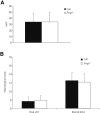The role of the octarepeat region in neuroprotective function of the cellular prion protein
- PMID: 17388948
- PMCID: PMC1859984
- DOI: 10.1111/j.1750-3639.2007.00061.x
The role of the octarepeat region in neuroprotective function of the cellular prion protein
Abstract
Structural alterations of the cellular prion protein (PrP(C)) seem to be the core of the pathogenesis of prion diseases. However, the physiological function of PrP(C )remains an enigma. Cell culture experiments have indicated that PrP(C) and in particular its N-terminal octarepeat region together with the phosphatidylinositol 3-kinase (PI3K)/Akt signaling pathways have a fundamental involvement in neuroprotection and oxidative stress reactions. We used wild-type mice, PrP knockout (Prnp(-/-)) animals and transgenic mice that lack the octarepeat region (C4/-) and subjected them to controlled ischemia. We identified an increased cleavage and synthesis of PrP(C) in ischemic brain areas of wild-type mice compared with sham controls. The infarct size in Prnp(-/-) animals was increased threefold when compared with wild-type mice. The infarct size in C4/- animals was identical to Prnp(-/-) mice, that is, around three times larger than in wild-type mice. We showed that the PrP in C4/- mice does not functionally rescue the Prnp(-/-) phenotype; furthermore it is unable to undergo beta cleavage, although an increased amount of C1 fragments was found in ischemic brain areas compared with sham controls. We demonstrated that the N-terminal octarepeat region has a lead function in PrP(C) physiology and neuroprotection against oxidative stress in vivo.
Figures






Similar articles
-
Aggravation of ischemic brain injury by prion protein deficiency: role of ERK-1/-2 and STAT-1.Neurobiol Dis. 2005 Nov;20(2):442-9. doi: 10.1016/j.nbd.2005.04.002. Neurobiol Dis. 2005. PMID: 15893468
-
Upregulation of cellular prion protein (PrPc) after focal cerebral ischemia and influence of lesion severity.Neurosci Lett. 2004 Nov 30;372(1-2):146-50. doi: 10.1016/j.neulet.2004.09.030. Neurosci Lett. 2004. PMID: 15531106
-
Activation of phosphatidylinositol 3-kinase by cellular prion protein and its role in cell survival.Biochem Biophys Res Commun. 2005 Jun 24;332(1):75-82. doi: 10.1016/j.bbrc.2005.04.099. Biochem Biophys Res Commun. 2005. PMID: 15896301
-
Physiological role of the cellular prion protein.Vet Res. 2008 Jul-Aug;39(4):9. doi: 10.1051/vetres:2007048. Epub 2007 Nov 27. Vet Res. 2008. PMID: 18073096 Review.
-
New insights into cellular prion protein (PrPc) functions: the "ying and yang" of a relevant protein.Brain Res Rev. 2009 Oct;61(2):170-84. doi: 10.1016/j.brainresrev.2009.06.002. Epub 2009 Jun 10. Brain Res Rev. 2009. PMID: 19523487 Review.
Cited by
-
Loss of anti-Bax function in Gerstmann-Sträussler-Scheinker syndrome-associated prion protein mutants.PLoS One. 2009 Aug 14;4(8):e6647. doi: 10.1371/journal.pone.0006647. PLoS One. 2009. PMID: 19680558 Free PMC article.
-
Identification of bilateral changes in TID1 expression in the 6-OHDA rat model of Parkinson's disease.PLoS One. 2011;6(10):e26045. doi: 10.1371/journal.pone.0026045. Epub 2011 Oct 7. PLoS One. 2011. PMID: 22016808 Free PMC article.
-
The two faces of protein misfolding: gain- and loss-of-function in neurodegenerative diseases.EMBO J. 2008 Jan 23;27(2):336-49. doi: 10.1038/sj.emboj.7601930. EMBO J. 2008. PMID: 18216876 Free PMC article. Review.
-
Prion Protein in Stem Cells: A Lipid Raft Component Involved in the Cellular Differentiation Process.Int J Mol Sci. 2020 Jun 11;21(11):4168. doi: 10.3390/ijms21114168. Int J Mol Sci. 2020. PMID: 32545192 Free PMC article. Review.
-
Inducing prion protein shedding as a neuroprotective and regenerative approach in pathological conditions of the brain: from theory to facts.Neural Regen Res. 2023 Sep;18(9):1869-1875. doi: 10.4103/1673-5374.366496. Neural Regen Res. 2023. PMID: 36926701 Free PMC article. Review.
References
-
- Bounhar Y, Zhang Y, Goodyer CG, LeBlanc A (2001) Prion protein protects human neurons against Bax‐mediated apoptosis. J Biol Chem 276:39145–39149. - PubMed
-
- Brown DR, Qin K, Herms JW, Madlung A, Manson J, Strome R, Fraser PE, Kruck T, Von Bohlen A, Schulz‐Schaeffer W, Giese A, Westaway D, Kretzschmar H (1997) The cellular prion protein binds copper in vivo. Nature 390:684–687. - PubMed
-
- Chen SG, Teplow DB, Parchi P, Teller JK, Gambetti P, Autilio‐Gambetti L (1995) Truncated forms of the human prion protein in normal brain and in prion diseases. J Biol Chem 270:19173–19180. - PubMed
-
- Drisaldi B, Coomaraswamy J, Mastrangelo P, Strome B, Yang J, Watts JC, Chishti MA, Marvi M, Windl O, Ahrens R, Major F, Sy MS, Kretzschmar H, Fraser PE, Mount HT, Westaway D (2004) Genetic mapping of activity determinants within cellular prion proteins: N‐terminal modules in PrPC offset pro‐apoptotic activity of the Doppel helix B/B′ region. J Biol Chem 279:55443–55454. - PubMed
Publication types
MeSH terms
Substances
LinkOut - more resources
Full Text Sources
Molecular Biology Databases
Research Materials
Miscellaneous

